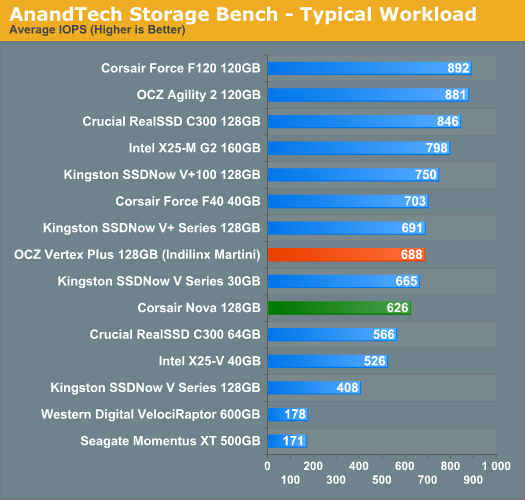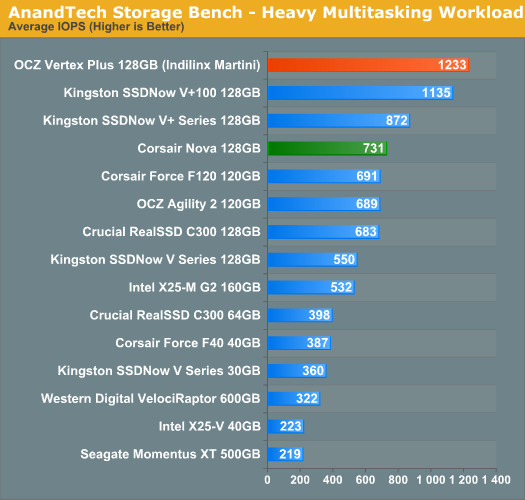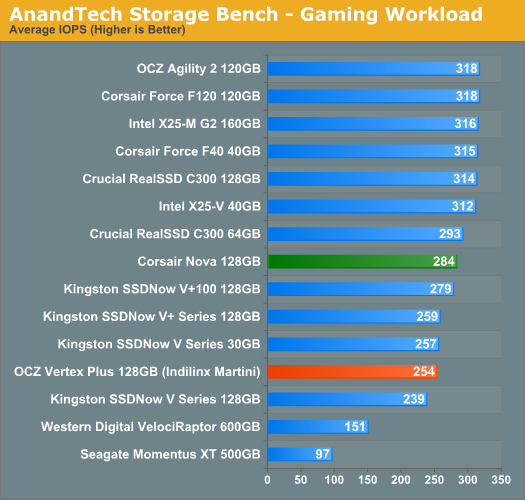OCZ Vertex Plus Preview: Introducing the Indilinx Martini
by Anand Lal Shimpi on November 16, 2010 9:31 AM EST- Posted in
- Storage
- SSDs
- OCZ
- Indilinx Martini
- Intrepid
AnandTech Storage Bench
To avoid any potential optimizations for industry standard benchmarks and to provide another example of real world performance we've assembled our own storage benchmarks that we've creatively named the AnandTech Storage Bench.
The first in our benchmark suite is a light/typical usage case. The Windows 7 system is loaded with Firefox, Office 2007 and Adobe Reader among other applications. With Firefox we browse web pages like Facebook, AnandTech, Digg and other sites. Outlook is also running and we use it to check emails, create and send a message with a PDF attachment. Adobe Reader is used to view some PDFs. Excel 2007 is used to create a spreadsheet, graphs and save the document. The same goes for Word 2007. We open and step through a presentation in PowerPoint 2007 received as an email attachment before saving it to the desktop. Finally we watch a bit of a Firefly episode in Windows Media Player 11.
There’s some level of multitasking going on here but it’s not unreasonable by any means. Generally the application tasks proceed linearly, with the exception of things like web browsing which may happen in between one of the other tasks.
The recording is played back on all of our drives here today. Remember that we’re isolating disk performance, all we’re doing is playing back every single disk access that happened in that ~5 minute period of usage. The light workload is composed of 37,501 reads and 20,268 writes. Over 30% of the IOs are 4KB, 11% are 16KB, 22% are 32KB and approximately 13% are 64KB in size. Less than 30% of the operations are absolutely sequential in nature. Average queue depth is 6.09 IOs.
The performance results are reported in average I/O Operations per Second (IOPS):

The Martini controller improves performance by around 10% compared to the Barefoot based Corsair Nova. It's enough to bring Indilinx's latest offering within striking distance of the new V+100 and smaller capacity SandForce drives, however the larger capacity SF drives are untouchable.
If there’s a light usage case there’s bound to be a heavy one. In this test we have Microsoft Security Essentials running in the background with real time virus scanning enabled. We also perform a quick scan in the middle of the test. Firefox, Outlook, Excel, Word and Powerpoint are all used the same as they were in the light test. We add Photoshop CS4 to the mix, opening a bunch of 12MP images, editing them, then saving them as highly compressed JPGs for web publishing. Windows 7’s picture viewer is used to view a bunch of pictures on the hard drive. We use 7-zip to create and extract .7z archives. Downloading is also prominently featured in our heavy test; we download large files from the Internet during portions of the benchmark, as well as use uTorrent to grab a couple of torrents. Some of the applications in use are installed during the benchmark, Windows updates are also installed. Towards the end of the test we launch World of Warcraft, play for a few minutes, then delete the folder. This test also takes into account all of the disk accesses that happen while the OS is booting.
The benchmark is 22 minutes long and it consists of 128,895 read operations and 72,411 write operations. Roughly 44% of all IOs were sequential. Approximately 30% of all accesses were 4KB in size, 12% were 16KB in size, 14% were 32KB and 20% were 64KB. Average queue depth was 3.59.

The Toshiba controllers have done very well in our heavy multitasking workload, as did the old Barefoot. Indilinx's Martini outdoes them both. The Vertex Plus is now our highest performing drive in our heavy multitasking workload. The SandForce drives fall short because much of this workload deals with incompressible data (JPEGs, .7z archives, etc...).
The gaming workload is made up of 75,206 read operations and only 4,592 write operations. Only 20% of the accesses are 4KB in size, nearly 40% are 64KB and 20% are 32KB. A whopping 69% of the IOs are sequential, meaning this is predominantly a sequential read benchmark. The average queue depth is 7.76 IOs.

Gaming performance took a slight hit compared to the old Barefoot. It's not enough to be a huge deal, especially considering the other improvements.










61 Comments
View All Comments
leexgx - Tuesday, November 16, 2010 - link
i agree 128gb would seem to be the min i would getgot the 256gb m225 my self before the £100 price increase i have 50gb free on that, i had an corsair s128 before that bit slow at writing but load times was quite fast, main thing that went faster was disk based installs like stream pre load decrypt (when you pre load an steam game its encrypted it has to decrypt Very disk intensive as it has to read and write a lot) as it would make my corsair S128 stall the system for short times as latency's whent up to 1000, m225 system is fully usable when it was decrypting blackops
apart from jmicron and older samsung first-second gen ssds, you be hard pressed to notice the difference unless you was doing server loads (like if i went from an m225 to an sf-1200 based ssd my pc mite boot up 1 second faster same goes for games and programs)
only reason you see me replacing this ssd is if i was getting an 512gb version (like i got money to burn :) ) or 2xSF-1200 based ssd's in raid 0 (as GC works good on them)
the segate XT drives may not seem that good but if your mainly only playing games or opening the same files often you could raid 3-4 of them in RAID 0 and that give you 16gb of cache data to work with
iamezza - Wednesday, November 17, 2010 - link
I would consider myself a power user, I spend much of the day on my PC working then later for gaming and I get by just fine with an 80GB SSD. I am currently using less than half capacity. Moving the user files in Windows 7 is a piece of piss, takes about 5mins and then its done, it's just drag and drop onto your storage drive.The only thing I can't do is install my games directory onto an SSD even a 128GB wouldn't be enough for that.
I recently installed a 30GB SSD into my HTPC and it works a treat. Being a HTPC everything apart from the OS goes onto a storage drive so 30GB is more than enough.
Mugur - Thursday, November 18, 2010 - link
You are right, regarding this particular case, but I can see from other small drives, like Corsair F40, Intel X25-V 40 GB etc. how the performance scales down... F40 looks almost similar to F120 and we all know with Intel 40 GB that they have half channels so the sequential write is the most affected, not so much other factors.Crucial - Tuesday, November 16, 2010 - link
All these reviews keep making me happy with my purchase of the 128mb Crucial drive. It seems to be a solid all around performer that still stays towards the top of the heap.Mr Perfect - Tuesday, November 16, 2010 - link
Not to divert this nifty SSD article, but if the drive manufacturers are so dead set on using round, metric numbers for their bytes, then I think I'm going to start calling them Metric Gigabytes and Imperial Gigabytes. It follows the current naming schemes much better then these ridiculous gibibytes. Who came up with that name anyhow?akedia - Tuesday, November 16, 2010 - link
*sighs*The prefix giga- is metric, while the prefix gibi- is binary. Your phrase "metric gigabyte" is redundant, while your "imperial gigabyte" is nonsensical.
A Gigabyte is 10^9, or 1,000,000,000, bytes. https://secure.wikimedia.org/wikipedia/en/wiki/Gig...
A Gibibyte is 2^30, or 1,073,741,824, bytes. https://secure.wikimedia.org/wikipedia/en/wiki/Gib...
Using the word gigabyte for those nice, round numbers is correct. The problem is operating system manufacturers whose systems display the number in the form of gibibytes. I'm not sure about others, but OS X now correctly displays gigabytes, erasing the apparent (but not actual) discrepancy between the box the drive came in and the system display about the drive.
In answer to your question about who named them, from the Wikipedia entry for Binary Prefix:
"The set of binary prefixes that were eventually adopted, now referred to as the "IEC prefixes," were first proposed by the International Union of Pure and Applied Chemistry's (IUPAC) Interdivisional Committee on Nomenclature and Symbols (IDCNS) in 1995. ... The new prefixes kibi (kilobinary), mebi (megabinary) and gibi (gigabinary) were also proposed at the time, and the proposed symbols for the prefixes were kb, Mb and Gb respectively, rather than Ki, Mi and Gi. The proposal was not accepted at the time.
"The Institute of Electrical and Electronic Engineers (IEEE) began to collaborate with the International Organization for Standardization (ISO) and International Electrotechnical Commission (IEC) to find acceptable names for binary prefixes. The IEC proposed kibi, mebi, gibi and tebi, with the symbols Ki, Mi, Gi and Ti respectively, in 1996.
"The names for the new prefixes are derived from the original SI prefixes combined with the term binary, but contracted, by taking the first two letters of the SI prefix and 'bi' from binary. The first letter of each such prefix is therefore identical to the corresponding SI prefixes, except for "K", which is used interchangeably with "k", whereas in SI, only the lower-case k represents 1000."
That's quite the user name for someone who can't manage a couple of Wikipedia lookups. The right to be outraged comes with the obligation to be informed.
Mr Perfect - Thursday, November 18, 2010 - link
Yes, it was supposed to be nonsensical. I apologize for not putting more ;) smilies in my post.Mr Perfect - Thursday, November 18, 2010 - link
Also, it wasn't just a troll post, since it apparently looks that way. I really AM annoyed at how the whole thing is being handled. Even though a 128Gib SSD really DOES have 128Gib on it, and is sold AS a 128Gib drive, the user space will be far less, depending on controller model. We're using the right units of measure, but people are STILL ending up with less then they thought they where. This was probably our one shot at getting accurate labeling on drives.I suppose I should have just said that, rather then try to have some fun with it. :|
FunBunny2 - Tuesday, November 16, 2010 - link
The real usecase for SSD is high normal form RDBMS. Let's get a TPC-C test of these things, using flatfile type schemas and BCNF type schemas; both on HDD (pick one for all tests going forward) and the SSD under test. Then we'll know whether they're worth the cost.dbt - Tuesday, November 16, 2010 - link
Garbage collection - really for the masses? Vendor laims that it will help where TRIM support is not available are confusing me.Which filesystems does garbage collection support? I'll bet FAT16/32/64(exfat) are covered, NTFS as well.
On other filesystems - how does the SSD controller know which blocks are "free" ?
EXT4/ZFS/<anyother>FS
?